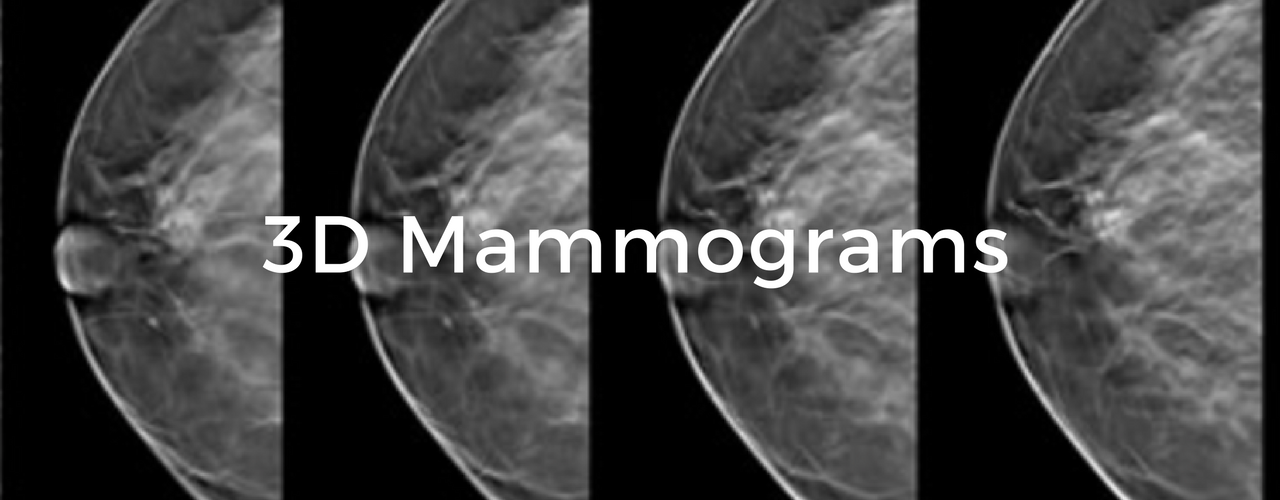Questions for your Primary Care Physician or Breast Surgeon:
- Should I have a 3D Mammogram?
- What are the benefits of 3D mammograms?
- Do I have significantly Dense Breasts on my prior mammograms?
- Am I at a High Risk for breast cancer in my lifetime?
- Is the extra cost covered by my insurance?
What is “3D mammography?”
“Three-dimensional” (3D) mammograms can image your breasts with better clarity than standard, “two-dimensional” digital mammograms. This new technology, also called “breast tomosynthesis”, will become the standard of care in breast screening in the next few years. 3D imaging is performed just like a normal mammogram but with an X-ray machine that moves during the imaging. The radiation dose is about the same as a digital mammogram.
A rotating X-ray machine creates detailed 3D images

3D mammograms capture images from more angles and uses computer technology to allow breast radiologists to not only find more cancers but lessens the chance you will be “called back” for further imaging studies. Women that have 3D mammograms also have a slightly lower chance of undergoing a “benign breast biopsy.” It is a leap forward in breast care and is slowly rolling out to breast imaging centers across the country.
Who benefits most from 3D Mammograms?
- Women with very Dense Breasts
- Younger Women (aged 40 to 49)
- Women at “High Risk” for developing breast cancer
Why is Breast Density a risk factor for cancer?
We have learned over time that women with dense breast tissue have a higher risk of developing breast cancer in their lifetime. Breast density is a term now used to describe how much glandular and supportive tissue appears on a mammogram. Studies estimate that if you have very dense breasts, your lifetime risk is twice and possibly up to four times the risk of others.
Dense breasts also make it more difficult for radiologists to see a small breast cancer because these growths can be overshadowed by the dense or “white” appearing tissue on a mammogram. 3D imaging helps address this “double-whammy” of increased risk and decreased ability to find breast cancers. The take-home message for those with dense breasts is to begin annual screening mammograms at 40 and ask for 3D mammograms, if available. Take our video lesson on “Breast Density” (here) to learn everything about this topic.
Why should younger women get 3D mammograms?
“Younger” women generally have denser breasts. In most women, breast tissue slowly becomes less dense as they begin to age. By younger for this discussion, we are referring to women aged 40 to 50 who undergo screening mammograms. More than half of women in this age group have dense breasts. Because it is more difficult to find small cancers in dense breasts by regular mammography, we recommend 3D imaging for all women younger than 50.
Why should women at “High-Risk” get 3D mammograms?
Women at high-risk for breast cancer will benefit most from 3D mammography. Some of these “High- Risk” factors include: BRCA mutation carriers, a prior breast biopsy that showed “atypical hyperplasia”, a strong family history of breast cancer, or radiation therapy to the chest region before the age of 30. Many of these same women will benefit from “Screening Breast MRI’s” in addition to annual screening mammograms.
Does insurance cover 3D mammograms?
Federal law mandates that all health insurance pays for “screening” studies such as routine digital mammography. 3D imaging is considered an additional study by many insurance companies and may not be covered. We expect more commercial insurance companies will cover the 3D part of screening mammograms in the future. Medicare and Medicaid do not currently cover the additional charge for 3D imaging. Some breast imaging centers do offer 3D imaging at no extra charge. It is worth asking about coverage and out-of-pocket costs when you schedule a mammogram.
Should I pay cash for a 3D mammogram?
Your breast imaging facility may ask you at the time of your mammogram if you are willing to pay for the 3D mammogram “add-on charge.” This charge ranges between $25 and $50. Sometimes that question may seem unexpected when you are undressed in the exam room or undergoing imaging. Inquire about the availability of 3D imaging when you arrive and ask what charges you might encounter. You will then have time to make an informed decision.
Patient-Friendly References:
This webpage (here) “Benefits of 3D Mammograms Last Over Time” outlines 3D imaging in more detail. This non-profit organization provides excellent patient resources about breast cancer.
This website is to help women ages 40 to 49 make decisions about when to start and how often to get screening mammograms. This “Mammogram Decision Aid” (here) was developed by Weill Cornell Medical College.
This page (here) on “Breast Cancer Screening for Women at Average Risk” is excellent and covers all the guidelines in easy-to-understand terms. The Susan G. Komen organization is a leading advocacy group dedicated to assisting patients, funding research, and ensuring quality breast cancer care.
Their website page (here), “Breast Density: What is it and what does it mean for me?” is a good overview of breast density for patients. This site is created for patients by the American Society of Breast Surgeons.
More Detailed References:
This document (here) “Consensus Statement on Screening Mammography” does an excellent job of synthesizing new guidelines while integrating 3D mammography into the discussion. The American Society of Breast Surgeons is a leading organization of surgeons who treat diseases of the breast.
If you want to get deep into the details about breast screening, find this free PDF 70-page document (here). It lists guidelines to help clinicians appropriately screen women for breast cancer. You can easily register (here) as a non-professional to get access to more information about breast cancer.



